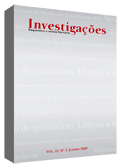Os imaginários sócio-discursivos sobre o homem do campo difundidos pelos quadrinhos de Chico Bento
Abstract
Por meio de uma análise do discurso das histórias em quadrinhos do personagem ChicoBento, de Maurício de Sousa, buscou-se identificar os imaginários sócio-discursivosreferente ao homem do campo brasileiro. Por meio das análises, com base nos estudosde Patrick Charaudeau, podemos identificar imaginários sócio-discursivos referentesa um homem do campo ordeiro, trabalhador e responsável. Este homem fundamentasuas crenças nas doutrinas religiosas e na sua própria experiência, evidenciando assimuma forte presença de valores como a intuição e a sensibilidade, oposta à racionalidadeapresentada pelos personagens urbanos.References
AMOSSY, R.; HERSCHBERG-PIERROT, A. 2005. Stéréotypes et Clichés: langue, discours,societé. Paris: Armand Colin.
CHARAUDEAU, P. 2006. Discurso Político. São Paulo: Contexto.
______. 2007. Les stéréotypes, c’est bien, les imaginaires, c’est mieux. In:
BOYER, Henri (Org). Stéréotypage, stéréotypes: fonctiontionnements ordinaires et mises en scène. Paris: L’Harmattan, pp.49-63.
PROCÓPIO, M. R. 2008. O ethos do homem do campo nos quadrinhos de Chico Bento. Belo Horizonte: FALE/UFMG. Dissertação de Mestrado.
SOUSA, M. 2007. Portal Turma da Mônica. Disponível em:
com.br> Acesso em: 06 jun. 2007.
VERGUEIRO, W. 1998. Alguns aspectos da sociedade e da cultura brasileiras nas histórias em quadrinhos. Revista Agaquê, São Paulo, v.1, n.1. Disponível em:
Acesso em: 03 jul. 2006.
Downloads
Published
How to Cite
Issue
Section
License
Copyright (c) 2009 Mariana Ramalho Procópio

This work is licensed under a Creative Commons Attribution 4.0 International License.
Authors who publish with Revista Investigações agree to the following terms:
Authors retain copyright and grant the journal right of first publication with the work simultaneously licensed under the Creative Commons Attribution 4.0 International (CC BY 4.0) license that allows others to share the work with an acknowledgement of the work's authorship and initial publication in this journal.
Authors are able to enter into separate, additional contractual arrangements for the non-exclusive distribution of the journal's published version of the work (e.g., post it to an institutional repository or publish it in a book), with an acknowledgement of its initial publication in this journal.
You are free to:
Share — copy and redistribute the material in any medium or format for any purpose, even commercially.
Adapt — remix, transform, and build upon the material for any purpose, even commercially.
The licensor cannot revoke these freedoms as long as you follow the license terms.
Under the following terms:
Attribution — You must give appropriate credit , provide a link to the license, and indicate if changes were made . You may do so in any reasonable manner, but not in any way that suggests the licensor endorses you or your use.
No additional restrictions — You may not apply legal terms or technological measures that legally restrict others from doing anything the license permits.

